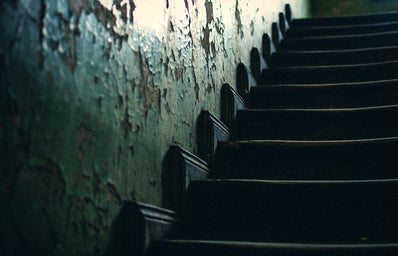“Wanting people to listen, you can’t just tap them on the shoulder anymore. You have to hit them with a sledgehammer. And then you’ll notice you’ve got their strict attention.”
‘Se7en’ is a film steeped in dystopia. Director David Fincher portrays the fundamental features of dystopia brilliantly and shockingly, employing spectacular visuals to thrill its audience with a frightful tale. The plot, set in New York, revolves around a serial killer Jonathan Doe who commits brutal murders and defends them because he has made the world a better place by exposing its unawareness and unspoken toleration of the Seven Deadly Sins. In Doe’s words, “We see a deadly sin in every street corner, in every home, and we tolerate it because it’s common and trivial. We tolerate it morning, noon, and night. Well, not anymore. I’m setting the example.”
The idea of a movie directed with a sledgehammer conjures up cruel clumsiness or maybe accidental expressionism. Observing the Jackson Pollock-like splatter of another senseless murder at the beginning of “Se7en,” William Somerset sighs, “Look at all that passion all over the wall.” From there, a series of precise strokes unfolds—its pace as finely calibrated as the metronome in Somerset’s study, its shocks as carefully curated as a museum retrospective. In this gallery analogy, there is an educational aspect to an artist using excess as a tool of communication and a real-world precedent for such pummeled innovations as the ones used by John Doe.
“Se7en” embodies and interrogates such blunt-force strategies, enfolding a meditation on—and enactment of—avant-garde artistry in genre-movie packaging. The film’s outer shape is that of a thriller, specifically the kind of gritty, big-city police procedural patented in the sweltering ’70s by Sidney Lumet: preparing for his first day on the job, David Mills (Brad Pitt) jokingly tells his wife Tracy (Gwyneth Paltrow), “Serpico’s got to go to work.” (“You might want to get rid of this little crusty in your eye, Serpico,” she responds sleepily). More significantly, “Se7en” establishes itself as a landmark in the history of serial-killer movies.
As with “American Psycho” and “The Silence of the Lambs,” “Se7en” draws its strength from a set of well-established conventions while also distancing itself from them. It does this mostly via the toxic potency of its visual style, which strips the rust off of the script’s cop movie tropes and exposes their gleaming bones. Meanwhile, the serial-killer material, which is so self-consciously lurid as to threaten unintentional comedy, is elevated, if not consecrated, by the story’s central gimmick: a suite of murders inspired by the seven deadly sins, carried out consecutively by John Doe as a sermon, wherein Old Testament messaging is etched on the bodies of his victims and conveyed to the masses by a sensation-hungry media establishment playing into his game.
As high concepts go, “Se7en’s” is dizzyingly vertiginous—which is to say pretentious, a quality the film owns straight-up. It’s most poetically expressed by the set piece in the silent, church-like library whose cavernous expanse is illuminated by a set of golden-hued desk lamps—a place of refuge and literary worship containing the wisdom of the ages. “All these books,” Detective Somerset sighs admiringly to the security guards while wandering the stacks to the strains of Bach’s Orchestral Suite No. 3 in D Major. “A world of knowledge at your fingertips … and you play cards.” Just as “Se7en’s” gore attempts to outstrip its predecessors, the film’s omnipresent intellectualism exceeds the po-faced Freudian slippage of “Psycho” or the Lacanian quid pro quo of “The Silence of the Lambs”; the film is pure pulp, but its gristle comes fully marinated in a thick stew of scriptural and liturgical references.
The story of two detectives trying to solve a series of murders inspired by the seven deadly sins might have ended up as your gimmicky, run-of-the-mill predictable thriller. Even the two protagonists—a seasoned veteran cop with decades of experience and a sense of serene disillusionment with the darkness he witnesses daily, agree to take a young, hot-tempered, optimistic detective under his wing, a man naively convinced he can make a real difference in a world of depressing indifference—are a certain kind of trope that had been explored countless times in a variety of genres, especially in buddy cop action comedies.
The by-the-book caring cop Somerset presents an odd contrast to his rookie new partner, the hardline, brash cop Mills (Brad Pitt). This opposition is established early in the film, but its full significance is only revealed in the final act when John Doe delivers the punchline to the moralizing but ultimately hypocritical Mills: the final of the seven deadly sins in the killer’s plan is committed by the self-proclaimed (and stereotypical) crime-fighter ‘hero’ Mills, who in his anger kills John Doe. This ending subverts the viewer’s expectations of the crime or thriller genre, whose conventions typically require neat closure achieved through the capture or obliteration of the villain and the subsequent consummation of the romance between the hero and his female helper.
Here Mill’s lover and the symbol of their consummation, her pregnancy, are utterly destroyed. Our heroic savior not only fails to protect her but also fails to deliver justice, when he joins in the killer’s symbolic plan and lowers himself to the same moral depravity.
Somerset alone remains morally intact. He stops the cycle of violence by vanquishing his demons – while Mills fails by looking for a scapegoat elsewhere. Somerset and Mills deal with their subconscious connections to Doe in very different ways. This is most apparent in the final car ride. We see an understanding if not a slight rapport between Somerset and Doe. For example, when Doe asks Somerset a question, he obligingly answers. Mills deals with Doe in a very different way; he instantly labels Doe as a ‘freak’. With no provocation Mills confronts Doe, saying, “When someone is insane, as you clearly are, do you know you are insane?…” Doe replies to this by saying, “It is more comfortable for you to label me insane” – making Mills even more insecure, as this is a very valid insight into Mills’ subconscious.
Somerset’s professional edge over Mills in successfully predicting the criminal’s next move, and his moral edge as a responsible protector figure, come not from his superior sleuthing, but from his ability to deal responsibly with his subconscious connection to Doe.
Detective Somerset also has much in common with killer John Doe but differs from him in his ability to control his urges.
What in common? For one, a cop and a ‘religious fanatic’ like Doe share similar motives. He is not a conventional serial killer in that his motive is to eradicate ‘sinners’. He feels he is killing to better mankind.
The parallel here with overzealous cops is only too evident. Not content to deal with the ‘monster’ legally and properly, Detective Mills is drawn into utter sympathy with a statement that Doe himself makes in defense of his meticulously orchestrated murders: after his arrest, Doe tells the two officers that “wanting people to listen, you can’t just tap them on the shoulder anymore, you have to hit them with a sledgehammer.”
The most striking thing is how both Doe and Mills are motivated by the same kind of puritanical lust for perfection – and how in both cases this perfection is sought, hypocritically, by eradicating the external source of evil (the ‘other’) while failing to turn the puritanical gaze inwards. In wanting to be responsible for other people’s behavior, both Doe and Mills perpetuate the wrongs they aspire to wipe clean.
But if this formulaic plot and predetermined, plainly distinguishable characters were put in the hands of a filmmaker who acknowledges that the true power of this particular story lies not so much in the action, but the psychology and atmosphere, and great actors—Freeman, Spacey, and Pitt—capable of making even cardboard cutouts seem alive, deep and believable, then magic can indeed happen. And it did: “Se7en” still stands out as one of the most exciting, most devastating, and most memorable thrillers Hollywood has produced in the last half a century. For such a hauntingly terrifying and gut-wrenching piece of mainstream entertainment, it’s surprising to note the film even garnered an Academy Award nomination (for best editing—lost to “Apollo 13”), as well as almost universal critical acclaim.
A solid marketing campaign and exceptional word-of-mouth promotion led “Se7en” to become, funnily enough, the seventh highest-grossing film of the year, earning 327 million dollars on a ten times smaller budget. Needless to say, the film opened doors for Fincher, who allegedly told his main stars this film probably wasn’t the one they would be remembered for but might be the one they would be proud of. He was only partially right, as “Se7en” stands tall in all of these great actors’ filmographies.
The film impresses with its visuals: the darkness was accentuated by a chemical process applied to the film stock, in which the silver wasn’t removed and hence deepened the shadows and helped set the unique visual tone.
Even though “Se7en” is elevated by supreme acting performances and Fincher’s masterful direction, which builds up the tension, as well as expert storytelling, where the filmmaker manages to almost effortlessly disgust and disturb us with only a single murder occurring on screen, what makes “Se7en” one of our favorites is the way the location of the plot plays a crucial role in the story as a whole. The setting, a New York immersed in darkness and drenched in constant, relentless drizzle, is just as vivid a character in this film as the detectives or the serial killer. The overall bleakness of the huge city superbly connects with the notions of moral decay and the complete indifference of society.
This leads us to the other reason “Se7en” is so loved here: the character of John Doe, whose screen time is disproportionate to his overall significance for the story. The sadistic murderer portrayed brilliantly subtly by Kevin Spacey is a brutal, uncompromising but highly intelligent and placid man who voluntarily takes on the assignment of purging the city of sin, carrying out several hideous killings as if they are an integral part of a mission handed to him by God of the Old Testament: unforgiving, relentless, eager to teach humanity a lesson. In some way, the whole weight of the film lies on Spacey’s shoulders and had a lesser actor been given this kind of responsibility, “Se7en” would have probably crumbled to pieces.
The violence in “Se7en” is fetishistic precisely because Doe is trying to make a moral statement through art (the detail that has gone into his murders and the records of his crimes display a perverse form of art). The film gets a reaction at the gut level and thus is arguably more effective than art which does not shock or disturb.
Yet the power of a disturbing and even disgusting film such as “Se7en” lies partly in our inability to put a comfortable distance between ourselves and the art. We respond as much to our own emotions and reactions as to the events on screen, and in a discomforting way we feel implicated in the violence that seems ‘other’ and ‘monstrous’. One may see this as a reflexive commentary, in which the Mills character represents our position vis-à-vis the horrors we see on screen. We may express disgust (or, as in my case, irritation or moral outrage) at violent acts pictured on screen, but systematic studies of the horror genre have suggested the opposite is the deeper truth – that the monster represents a projection of wish-fulfillment and an ‘escape’ from internal and external sensors which repress our subconscious desires. Yet like Mills, we may be unaware how much the monsters we celebrate on screen year after year resemble our inner psyches.
One of the pleasures of the crime/thriller genre is the moment of catharsis when we see the monster blown to smithereens by the sympathetic hero. Not only does this make us feel vicariously omnipotent, but it also allows our lust for violent revenge to be expressed relatively harmlessly. After all, like Mills, we’re torn between a moral repulsion at barbaric acts and a subconscious desire to inflict equally repugnant punishments on their perpetrators, and so eradicate such crimes by equally forbidden and extreme means. This fantasy is part of what makes violent horror and crime movies so persistently popular. The genius of “Se7en” is the way it exposes and reflects our hypocrisy about this.


